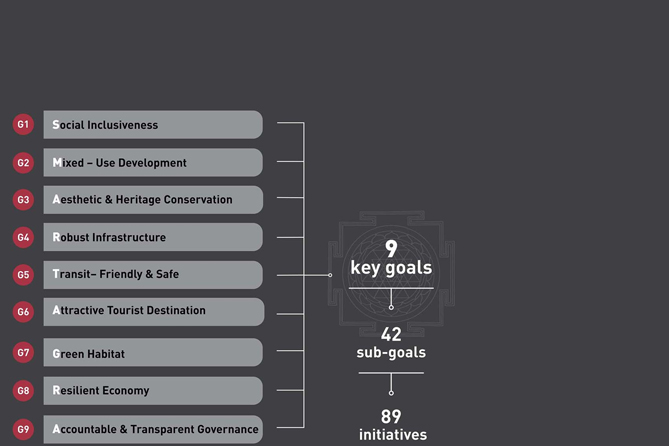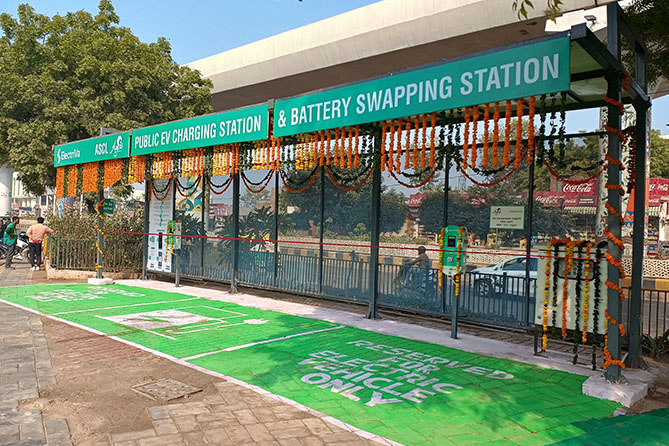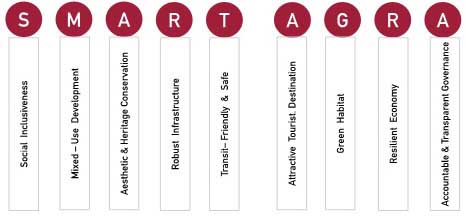Strategic Plan
Strategic Plan





SMART AGRA
The strategic plan for Agra Smart City identifies 9 key goals, that have been further divided into 42 sub-goals and 89 initiatives.
G1 – Social Inclusiveness:
SG – 1.1: Setting-up digital literacy centers for providing IT training and micro skill centers for imparting training related to local art such as in-lay, sculpting and zardosi work by 2019.
SG – 1.2: Rehabilitation and in-situ development of slums and unauthorized colonies.
SG – 1.3: Provision of basic infrastructure to enhance livability in slums.
SG – 1.4: Availability of and accessibility to social infrastructure such schools, PHCs.
SG – 1.5: Provision of affordable primary, secondary and tertiary healthcare services.
G2 – Mixed-use Development:

SG – 2.1: Developing 175 hectares of tourism hub along Fatehabad Road by 2021.
SG – 2.2: Integrated township and commercial development by leveraging the greenfield areas of the city by 2025.
SG – 2.3: Using transit orientated development principle along the metro corridor for a compact, high density mixed-use development.
G3 – Aesthetic and Heritage Conservation:
SG – 3.1: Revival and beautification of the existing 48 ASI sites in the city by 2021.
SG – 3.2: Formulating and implementing urban design guideline for area around the
monuments.
G4 – Robust Infrastructure – to enhance livability:
SG – 4.1: Open-defecation- free Agra with 100% coverage of individual toilets and 100% underground sewage network by 2019.
SG – 4.2: 100% D2D collection of solid waste with segregation and 100% scientific disposal of waste using waste to energy plant by 2019.
SG – 4.3: Conversion of 100% streetlights to LED by 2019.
SG – 4.4: 24×7 water supply with SCADA system and 100% smart metering by 2021.
SG – 4.5: 24×7 power supply with smart grid and smart metering by 2021.
SG – 4.6: 100% of the road covered with underground utility duct to reduce maintenance cost, improve aesthetic appeal, and provide assured safety by 2021.
SG – 4.7: To meet 10% of city’s water demand through rainwater harvesting by 2025.
G5 – Transit-friendly and Safe:
SG – 5.1: Provision of common mobility card to make payment across all modes of transport by 2018.
SG – 5.2: Improve safety and security through digital surveillance system and citizen
vigilance team by 2019.
SG – 5.3: Developing tourist management plan by providing hop-on, hop-off tourist bus services, cycle sharing scheme and creation of walkways by 2021.
SG – 5.4: Provide frequent, fast, reliable and affordable mass transit corridor across the city and increase the share of public transport usage from 4% to 10% by 2021 and 25% by 2035.
SG – 5.5: Creating dedicated 216 km cycle tracks or cycle lanes and 290 km of footpath to promote NMT by 2025.
SG – 5.6: Laying 30 km of metro corridor to provide connectivity across the city.
SG – 5.7: Establishing feeder connectivity through bus and last mile connectivity through cycle sharing.
SG – 5.8: Establishing 9 vehicle parking spaces at different locations through out the city with a capacity of 2700 passenger car units (PCU) by 2025
G6 – Attractive Tourist Destination:
SG – 6.1: Creating tourism-hub comprising of various tourist attraction such as the proposed Mughal museum, Mughal garden, sports stadium and amusement park.
SG – 6.2: Increasing the tourist stay in the city by promoting evening heritage walks,evening markets, stalls, that showcase the culture of the city.
SG – 6.3: Organizing local festivals such as Taj Mahotsav, hot air balloon festival, etc. on a frequent basis.
SG – 6.4: Creating a formal platform for displaying local economic activities such as petha making, in-lay work, zardosi work, and other such traditional skilled work.
SG – 6.5: Encouraging schools and colleges to conduct industrial visits to view the
shoe factories in Agra.
G7 – Green Habitat:
SG – 7.1: Creating at least five 100% municipal-waste wards across the city by 2021.
SG – 7.2: Achieving 50% recycling and reuse of wastewater by 2021.
SG – 7.3: Acquiring 10% of energy requirement from renewable energy sources by 2021.
SG – 7.4: Creating green area so that green cover increases from 2.13sq.m/person to at least 6sq.m./person.
G8 – Resilient Economy:
SG – 8.1: Creating a diverse economy which is resilient to shocks of fluctuations in tourist influx of the city by providing an impetus to the existing industries such as leather shoe industry, petha industry, handicraft industry, etc.
SG – 8.2: Promoting and creating favourable policy environment for setting-up of
non-polluting industries such as agro and agro processing, nutraceuticals, biometrics, medical equipment, BPOs/KPOs, IT-industry, BFSI, etc.
SG – 8.3: Leveraging on existing hospitals and medical facilities to create a Medi-city.
G9 – Accountable and Transparent Governance:
SG – 9.1: Integrated common toll-free number, mobile app and website for monitoring
and grievance redress of all basic services by 2018.
SG – 9.2: Create a one-stop-destination for applying (connection) of all basic services by 2019.Information dissemination system that provides basic information to
citizens regarding weather, safety and security, traffic, epidemics and hazards through SMS by 2019.
SG – 9.3: Robust optic fibre network with WiFi spots across the city by 2025.
SG – 9.4: Increase availability of own-revenue sources of ULB by using tools such as development charges, impact fees, etc.
SG – 9.5: Promote and support engagement of citizens and empower citizens to understand, evaluate and analyze information using digital technology.
